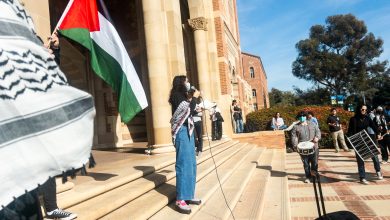Profit Over People: UC Investments

Design by Cass Sanchez
Blue and yellow fighter jets fly through the center of the image, in front of gold coins falling into a pot with the words “UCLA Invests” written on the rim in blue and yellow.
This project was co-authored by FEM and UC Divest. This article was created in collaboration with UC Divest member organizations, including SJP, SLAP, Anakbayan, JVP, and MEChA.
As the “number one public university,” UCLA is widely known for being an academic research powerhouse and symbol of Californian optimism and innovation. Since the late 20th century, however, UC-wide and campus-specific administrators have been working behind the scenes to add another dimension to the university’s mission — wealth accumulation.
Administrators carry out this goal by investing their institution’s endowment and other assets. Despite the scale of wealth accumulation, and its centrality to the jobs of many top administrators, this aspect of UC(LA)’s funding is poorly understood. Beneath the glossy promotional materials showing how the money could be spent, the fact remains that endowment-funded scholarships, research institutes, and faculty hires are made possible by investment in violent corporations like Lockheed Martin. University financial executives are complicit in harming students and workers on campus, as well as communities abroad.
Endowments are funds donated to tax-exempt charitable institutions, often for specific purposes like the establishment of scholarships, which are invested in order to provide a perpetual stream of funding in the form of investment returns. Endowments are not unique to higher education; hospitals, for example, often have them. However, the largest endowments tend to belong to prestigious universities, with Harvard topping the national rankings and the UC system coming in 11th overall.
The main purpose of endowments is to fund university operations in perpetuity. In theory, they are supposed to act as a buffer, allowing wealthier institutions to weather tough periods, like the drop in enrollment and revenue caused by COVID-19 (this is rarely the case in practice, as I’ll discuss below). The UCLA Foundation, the institution that manages UCLA’s endowed finances, echoes this sentiment, stating “Investment returns are expected to preserve or enhance the real value of the endowment to provide adequate funds to sufficiently support designated university activities . . . in perpetuity.”
Within the UC system, endowed investments can be divided into two broad categories based on who manages them: UC-wide investments or campus-specific foundations. Donations made to the University of California are pooled into the General Endowment Plan (GEP), controlled by the regents, and managed by UC Investments which is housed under the UC Office of the President.
All ten campuses, meanwhile, have their own foundations to manage and invest endowed donations. At UCLA, endowed donations are entrusted to the UCLA Foundation and managed by the UCLA Investment Company. At the end of the 2021-2022 fiscal year, the UCLA Foundation had $4.5 billion in net assets, while the GEP closed out the year with $18.2 billion.
Endowments weren’t always this big. Though the rise of the modern university endowment can be traced to the 1890s, endowments at today’s scale go back less than half a century. According to a 2014 article by Brown et al. in the American Economic Review, “Much of this endowment growth is attributable to positive returns that resulted from the gradual shift of endowment investments from fixed income to equities in the 1970s and 1980s, followed by a shift towards alternative assets such as hedge funds, private equity, and venture capital in the 1990s and 2000s.”
Moving away from fixed income, which provides slow and stable returns, into private sector investment in the free and deregulated market, where booms are always followed by busts, promises larger returns premised on the unspoken understanding that it could all melt away. This makes equity inherently risky, with potentially disastrous impacts on people like pensioners, whose retirement plans are invested in private equity at alarming rates.
This explosive growth in endowments is an imposition of neoliberal ideology, which is characterized by global deregulation and financialization. Today, endowments are invested in all manner of things. In its 2022 Endowment in Action report, the UCLA Foundation included a pie chart showing asset allocation: 6.5% in real estate, 10.2% in natural resources, 19.4% in independent return, and a whopping 60% in equity. This last category, which generally refers to owning stocks or shares in a company, is further divided between public equity (39%), private equity (11.8%), and venture capital (9.3%).
There are many issues with this bigger-is-better approach to endowments. The most common critique is that not all institutions can share the wealth. Endowment sizes are highly unequal across educational institutions, with a few of the most prestigious schools commanding the vast majority of endowment dollars. At the end of the 2016 school year, four universities held 20% of the total value of US higher education endowments.
This means only a select few universities can rely on endowments to add new programs or to protect university finances in times of trouble, while more schools across the country close each year. As charitable donations, endowments are functionally subsidized by taxpayers due to their tax-exempt status. If the true goal is educational equity, public funds would be much more effective when allocated toward schools like UC Merced and UC Riverside, who serve the largest number of low income students and students of color with the system’s smallest endowments.
A second, related issue with educational endowments is hoarding, which contradicts their stated function of supporting educational operations. The system is supposed to provide annual payouts to the university, which make up a portion of the school’s annual operating budget. In times of prosperity, when returns increase, payout increases from endowments are typically small to nonexistent. When endowment investments suffer, however, annual payouts are quickly cut, protecting the endowment over the institution’s overall health and ability to serve its students.
Meanwhile, the Regents and campus foundations are incentivized to build their endowments through college rankings that privilege wealthy institutions. Endowments for schools like UCLA are, in the long run, only growing — but their spending has not kept pace, showing that those in charge of the UC(LA) endowment(s) overvalue monetary returns and undervalue the returns generated by investing in great educators, scholarship programs, and student resources.
The structural issues of university endowments and financial management described above allows UC(LA) to use its ballooning fortunes to invest in violent, predatory, and conservative corporations. Though we may not be aware of it, UC(LA)’s quiet transformation into a financial powerhouse impacts the world, affecting people in California, Hawaii, Palestine, the Philippines, and beyond.
Our struggles as people harmed by the UC are interlinked. The UC invests in Israeli apartheid through companies like BlackRock and Lockheed Martin, then signs a deal with the mega-landlord Blackstone while students and faculty face suffocatingly high rents across the state. Administrators minimize funding for wages, scholarships, resources, and infrastructure to protect the endowment.
Historically, UC(LA) has only changed their investment practices in the face of sustained, widespread opposition from the community, such as student coalitions like UC Divest, whose anti-capitalist, anti-racist, anti-imperialist and anti-war mission aligns with FEM’s. UC(LA)’s shadowy investment practices have gone largely unscrutinized for decades, which is precisely what has allowed the endowment to flourish at the expense of students, staff, and communities around the world whose oppression is funded in part by UC(LA) dollars. The first step in dismantling this machine, which turns tuition into bombs and violence into profit, is education and awareness.
Read the companion to this article here.




